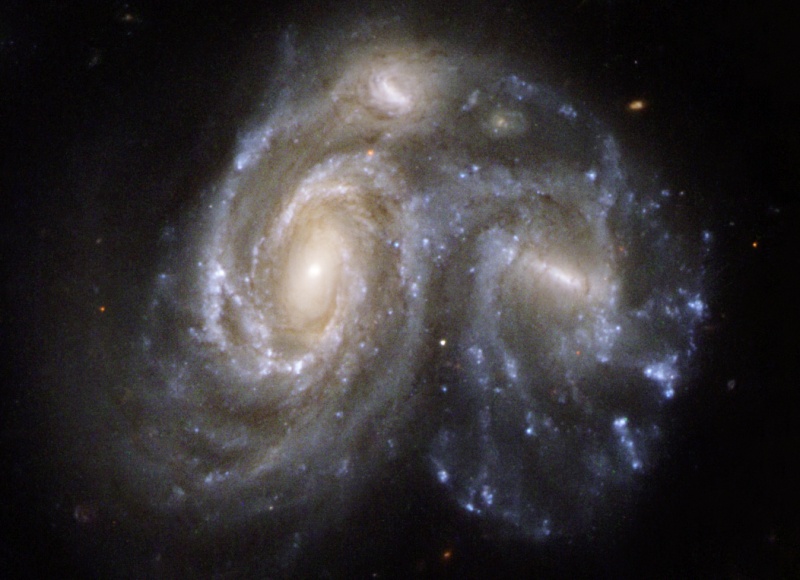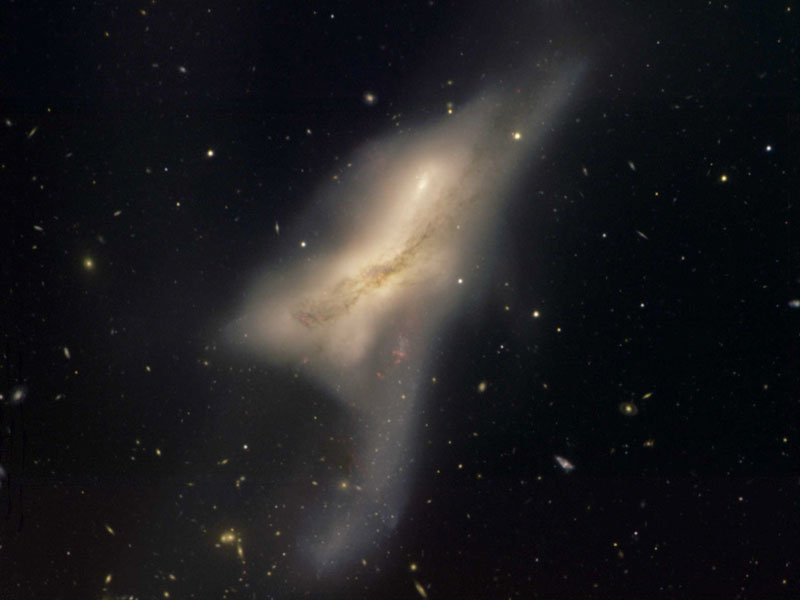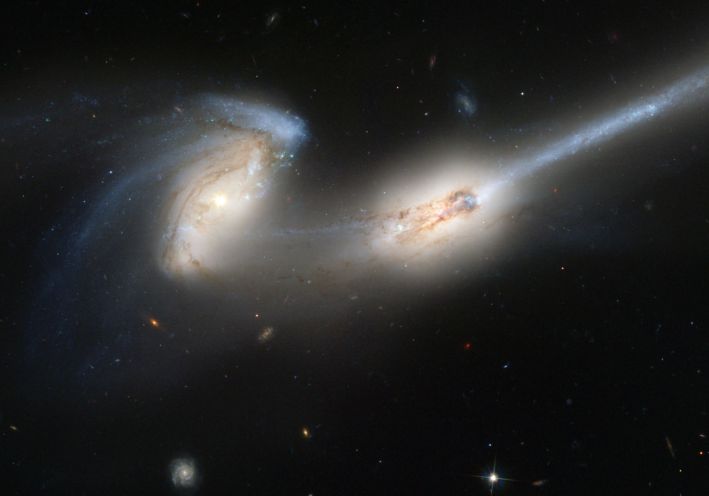Page 1 of 3
Arp 272, a third galaxy? (APOD 30 Apr 2008)
Posted: Wed Apr 30, 2008 4:19 am
by ta152h0
a third galaxy ?
Posted: Wed Apr 30, 2008 5:42 am
by s_h_r_a
Can anyone see the third galaxy in this image?
About 12 o'clock, another galaxy core can be seen ! Am I correct ?
Re: Arp 272, a third galaxy? (APOD 30 Apr 2008)
Posted: Wed Apr 30, 2008 10:10 am
by henk21cm
ta152h0 wrote:If all the light being produced by each individual; star would arrive on Earth at the same time, what would a galaxy look like ?
G'day mates,
It would look the same as now. There are two arguments for this statement:
- 1) The lifetime of stars is long compared to the difference in time for light from the most far away parts of a galaxy.
2) The formation of stars in a galaxy is more or less a continuous process, dying stars regenerate clouds of gas into new stars.
Ad 1) A simple analogon. Suppose we have a family. Mother and the children live in New York, father works in Seatle. Now we take pictures of father and of mother and her children, put these pictures in envelopes and send these via surface mail (boat) to Europe. A picture from Seatle has to cross the Pacific, Indian Ocean, around the Cape and via the Atlantic to Europe. A picture of the mother only has to cross the Altantic and arives a month earlier than a picture of the father. So we take the picture of the father one month earlier than the picture of the mother and her children. We send the picture of the father one month earlier, so both pictures arrive at the same day in Europe. Nevertheless, when we combine all pictures, we see just a normal family: the father is not extremely young compared to the mother, or even younger than his children. The time difference (one month) in delivery is short compared to the human average lifetime (75 years). In a similar way is the time difference of maybe 50 kyears short compared to the lifetime of a star, 1 Gyears.
Ad 2) One could argue that the bright short-living stars in the far regions of the galaxy not yet died when the photons of these stars left tfor our eyes, whereas similar stars in the close regions of the galaxy have died in the meanwhile. Stars are continuously generated, see APODs numerous photo's of the star forming areas of the last month or so.
The 3rd galaxy, a lumb of stars 'at 12 o'clock', is IMHO a fluctuation in density of stars. If you visit the Galcrash website,
http://burro.cwru.edu/JavaLab/GalCrashWeb/ you can see a similar lumb of stars when the two galaxies cross each other. This lumb is rather short lived, visible at the 6 o'clock position.
Re: a third galaxy ?
Posted: Wed Apr 30, 2008 12:38 pm
by dduggan47
s_h_r_a wrote:Can anyone see the third galaxy in this image?
About 12 o'clock, another galaxy core can be seen ! Am I correct ?
I had the same question. That's what it looks like to me. If so, it's odd that it isn't mentioned in the description. Is it really just a smaller foreground galaxy?
Re: Arp 272, a third galaxy? (APOD 30 Apr 2008)
Posted: Wed Apr 30, 2008 12:39 pm
by bystander
s_h_r_a wrote:Can anyone see the third galaxy in this image? About 12 o'clock, another galaxy core can be seen ! Am I correct ?
henk21cm wrote:The 3rd galaxy, a lumb of stars 'at 12 o'clock', is IMHO a fluctuation in density of stars. If you visit the Galcrash website,
http://burro.cwru.edu/JavaLab/GalCrashWeb/ you can see a similar lumb of stars when the two galaxies cross each other. This lumb is rather short lived, visible at the 6 o'clock position.
In the GalCrash website video, the "lumb", as you say, is just one of the two galaxy cores that crashed. I have to say, when I saw today's APOD, my first impression was the same as shra's, but the explanation does not mention three galaxies colliding. But, it still looks like three cores to me.
Re: a third galaxy ?
Posted: Wed Apr 30, 2008 12:58 pm
by orin stepanek
s_h_r_a wrote:Can anyone see the third galaxy in this image?
About 12 o'clock, another galaxy core can be seen ! Am I correct ?
Maybe even a fourth smaller one next to the right of the third one. Did anyone notice that the two larger ones are spiraled in the opposite direction? It would be interesting to note how this all works out when the merging is complete. 8)
http://apod.nasa.gov/apod/ap080430.html
Orin
Posted: Wed Apr 30, 2008 1:03 pm
by bystander
Posted: Wed Apr 30, 2008 1:10 pm
by bystander
If you look at
ARP 272 in
Dr. Halton C. Arp's Atlas of Peculiar Galaxies, the negative supports the three galaxy core theory.
let us assume
Posted: Wed Apr 30, 2008 3:57 pm
by ta152h0
Let us assume we are in a classroom atmosphere and have the liberty of discussing astronomy and ignore time warp for the duration. Let us assume we are looking at a galaxy 70000 light years across and two supernovae manifest themselves at the same exact moment, one in the near side and the other, 70000 light years further away. If time warp did not exist and we would see this at the same time, not 70000 years apart, how would this galaxy look like ?
Galaxies April 30/08
Posted: Wed Apr 30, 2008 4:04 pm
by Sputnick
http://antwrp.gsfc.nasa.gov/apod/astropix.html
This is an outstandingly beautiful photo of two merging galaxies (the term 'colliding' implying destruction which is theorized not to happen in merging galaxies, except in the eventual ending of both galaxies' individual identities) - ((I wish I knew how to attach the image here)) but no mention is made of the 'small' third topside galaxy which although 'far away' relatively is definitely obviously without question affecting the outer arms of the colliding galaxies .. the galaxy on the right side's outer arm being drawn down by the clockwise rotation of the top galaxy, the leftside galaxy's outer arm being drawn upwards by the topside galaxy's rotation. 'Gravity well' might be one explanation, but how about this - the small galaxy's rotation could be creating a far reaching 'funnel' or 'whirlpool' effect in the theoretical Dark Matter and Dark Energy.
By the way - I have noticed on surfaces of moving water where lines of differing velocities meet that small whirlpools resembling spiral galaxies are created .. the whirlpools moving along the line of highest velocity. I think Dark Matter and Dark Energy have flows, circulation perhaps, currents, and these may be part of the creation processes for galaxies.[/img]
Re: let us assume
Posted: Wed Apr 30, 2008 4:14 pm
by Case
ta152h0 wrote:how would this galaxy look like ?

You would see a galaxy with two supernovae, instead of one at a time. I'm not sure why you would think this situation is so special. Supernovae are local events; the galaxy as a whole isn't that much affected by it. Supernovae dim down in weeks or months. After that time they are hard to detect in far away galaxies.
Re: Arp 272, a third galaxy? (APOD 30 Apr 2008)
Posted: Wed Apr 30, 2008 4:20 pm
by neufer
henk21cm wrote:ta152h0 wrote:If all the light being produced by each individual; star would arrive on Earth at the same time, what would a galaxy look like ?
It would look the same as now. There are two arguments for this statement:
- 1) The lifetime of stars is long compared to the difference in time for light from the most far away parts of a galaxy.
2) The formation of stars in a galaxy is more or less a continuous process, dying stars regenerate clouds of gas into new stars.
Also the stars are moving only a thousandth of the speed of light.
Third Galaxy
Posted: Wed Apr 30, 2008 4:25 pm
by Sputnick
I apologize for opening a new thread on this photo before noticing this thread.
Yes I do see the third, topside galaxy in this photo of two merging galaxies (I will not use the term 'colliding' as the term 'colliding' implies destruction which is theorized not to happen in merging galaxies, except in the eventual ending of both galaxies' individual identities) -
the 'small' third topside galaxy which although 'far away' relatively is definitely obviously without question affecting the outer arms of the two merging galaxies .. the galaxy on the right side's outer arm being drawn down by the clockwise rotation of the top galaxy, the leftside galaxy's outer arm being drawn upwards by the topside galaxy's rotation. 'Gravity well' of the third galaxy might be one explanation, but how about this - the small galaxy's rotation could be creating a far-reaching 'funnel' or 'whirlpool' effect in the theoretical Dark Matter and Dark Energy.
By the way - I have noticed on surfaces of moving water where lines of differing velocities meet that small whirlpools resembling spiral galaxies are created .. the whirlpools moving slowly along the line of highest velocity. I think Dark Matter and Dark Energy have flows, circulation perhaps, currents, and these may be part of the creation processes for galaxies.
Orin - I think the counter-revolving galaxies will slow each others' rotation and their merge will create a globular galaxy. This photo
http://spdext.estec.esa.nl:81/science-e ... ctid=42670 in my opinion being merged, stopped-revolution galaxies
whose stellar wind will drive the dark gas/particle clouds away and leave a clear, globular galaxy.
Re: Third Galaxy
Posted: Wed Apr 30, 2008 4:34 pm
by dduggan47
Sputnick wrote:
Orin - I think the counter-revolving galaxies will slow each others' rotation and their merge will create a globular galaxy.
That's interesting. As the rotation decreased would the galaxy become increasingly compact?
Posted: Wed Apr 30, 2008 4:44 pm
by Sputnick
Duggan - I think the globular galaxy might be the same density - but the matter evenly distributed. Globular galaxies seem beautifully balanced.
Also - yes, the even smaller, (even more distant) fourth galaxy in the image (top right - under the outermost arm of the rightside large galaxy) is also effecting the merge - in particular its rotation drawing the large arm upwards. To me, this means that the theoretical whirlpool/funnels have extremely long range effect.
I think globular clusters form where currents in Dark Matter/Dark Energy (and possibly Time) are dissipated - areas of no flow - if Time is in a No Flow situation, a minute would be a very long time .. and if Time was caught in a reverse current, well, wouldn't the possibilities be interesting?
Posted: Wed Apr 30, 2008 4:53 pm
by Sputnick
Henck - your lumb of stars is a computer simulation only - not real space time matter. Computer simulations are operated by the imagination of people. I think the third and fourth galaxies are what they appear to be .. galaxies, far removed from the two main galaxies, and affecting the appearance of the arms.
Posted: Wed Apr 30, 2008 5:03 pm
by BMAONE23
I see what looks like a 4th galaxy in the "Bubble" area top right of the smaller 3rd galaxy at the top left

Sput.,
If you hit "Quote" on my post you will see the coding needed to post an image
Posted: Wed Apr 30, 2008 5:09 pm
by BMAONE23
It appears to me to be a third galaxy also...A Large Spiral to the left of the image, A slightly smaller Barred Spiral to the right side and a small Barred Spiral at the top. (possibly an even smaller irregular in the bubble area to the right of the small Barred Spiral

Posted: Wed Apr 30, 2008 5:19 pm
by Sputnick
Yes, BMA - with the rotations of the two small galaxies definitely shaping the paths of the outer, upper arms of the two large galaxies.
Simple when a person thinks of it - if Dark Matter and Dark Engery affect the shape of a spiral galaxy, then the rotation of the spiral must create movement in the Dark Matter and Dark Energy. Funnels .. and with energy in space being so immense - the funnels will be far reaching. Scientists should be searching our galaxy for effects of a funnel from Andromeda.
These funnels will probably be Time funnels also - creating the effect that when viewing a spiral face-on, the spiral appears to be a funnel .. but when spirals are viewed edge on, the effect is absent.
Posted: Wed Apr 30, 2008 5:26 pm
by orin stepanek
Sputnick; I think the lesser one may turn (like a pancake) making the merge easier. But who knows for sure. The opposite rotations may even cause them to bounce off each other a couple of times before they eventually merge completely, Should be a lot of accelerated star formation though.
Orin
Posted: Wed Apr 30, 2008 5:33 pm
by Sputnick
Orin - next time you're standing on a bridge over a river or canal, or on a riverbank, search the currents for spiral galaxies of foam and debris where current lines meet.
Posted: Wed Apr 30, 2008 6:24 pm
by iamlucky13
I find it interesting that these two galaxies are so intact and undistorted, yet some of the past APOD's of galactic collisions or mergers show major stretching and deformation. I suppose it could be simply a factor of their relative velocities, where slower mergers allow more time for galaxies to pull each other apart, or how long they've been in proximity, but the difference is sometimes striking.
However, are they sure that we aren't simply seeing two (or three)galaxies separated along our line of site by a few million light-years? Red-shift distance measurements have limited accuracy.


[/img]
Posted: Wed Apr 30, 2008 6:35 pm
by Case
Sputnick wrote:search the currents for spirals of foam and debris where current lines meet.
We know very little about the distribution of dark matter and about the interaction of dark matter with 'normal' matter.
'Detailed' simulations of the distribution only give a diffuse cloud-like appearance without much structure. However, it is very unlikely that the interaction is very similar to the friction-type interaction that can be observed in fluids, as friction and currents do not apply here.
Pattern recognition may be a good starting point, but it has to be backed by sound theory and observations. As it stand now, we have only the gravitational effect of dark matter.
Posted: Wed Apr 30, 2008 6:47 pm
by Sputnick
Case - " ... as friction and currents do not apply here."
How do you know friction and currents do not apply here? Currents apply in electricity. Magnetism can be like friction in dragging elements along or hindering their forward motion. (Example being maglev trains).
What we know is miniscule - what we don't know is immense.
The Physics Professor says, "Arrest that Jesus guy, and put him in prison! Walking on water is against the law of gravity!"
I am lucky - As stars within galaxies are said to be too far apart to come into contact with each other as galaxies merge, galaxies could theoretically pass through each other a few times without altering shape greatly until their gravitational influences slow their speeds relative to each other. I think the photo is evidence of this.
Posted: Wed Apr 30, 2008 7:09 pm
by Case
iamlucky13 wrote:I find it interesting that these two galaxies are so intact and undistorted, yet some of the past APOD's of galactic collisions or mergers show major stretching and deformation.
Perhaps the two almost intact galaxies are just getting close to each other for the first time, while the more distorted galaxies have already crossed paths, like a before-and-after comparison. N-body simulations seem to predict that:







